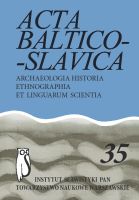Bobrujszczyna – ojczyzna Floriana Czarnyszewicza wczoraj i dziś (Raport z badań terenowych)
Babruysk district – homeland to Florian Czarnyszewicz yesterday and today (Report of field research
Author(s): Małgorzata Ostrówka, Ewa GolachowskaSubject(s): Language and Literature Studies
Published by: Instytut Slawistyki Polskiej Akademii Nauk
Keywords: Belarus; Babruysk; history; sociolinguistic situation; Catholic Church
Summary/Abstract: Field research in Babruysk and vincinity taken up recently is part of research of the religious language of Catholics in former North-Eastern Polish Borderland and writings of Florian Czarnyszewicz, who comes from Babruysk Disctrict, the author of several novels, the most famous of which is called Nadberezhyntsy. The article presents short history of Babruysk with special attention drawn to cultural – educational problems and the dynamics of population development in this town. It shows functioning of the Catholic Church in Babruysk District in 20th and 21st centuries. It also discusses the language situation in the researched area which is as follows: the primary language in the town is Russian with elements of Belorussian. This language demonstrates great idiolectal diversity. People who live in the country and have never left it use a Belorussian dialect (which confirms the principle that living in the country favours preserving the dialect). The Polish language is present only during the liturgy and prayers of the eldest generation. During Masses said in Polish the Polish language is used for Eucharistic Liturgy but during the Liturgy of the Word Polish is present only for the reading. The sermon is preached in Belorussian. Belorussian is also used for pastoral announcements. Numerous participants of the Mass can be the proof of attachment to the Polish language as the language of liturgy. During the research trip we visited four cemetaries where we photographed 87 tombs. As for these tombs, we were certain that they belonged to Poles (as surnames, names or father’s names indicated). 33 inscriptions out of this number were engraved in Latin alphabet. We could observe mixing Latin types with Cyrillic ones. The appendix given at the end of the article contains texts of an informant from Prodwin written phonetically.
Journal: Acta Baltico Slavica
- Issue Year: 2011
- Issue No: 35
- Page Range: 237-263
- Page Count: 27
- Language: Polish

